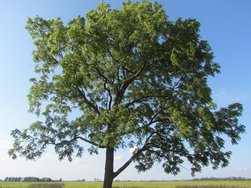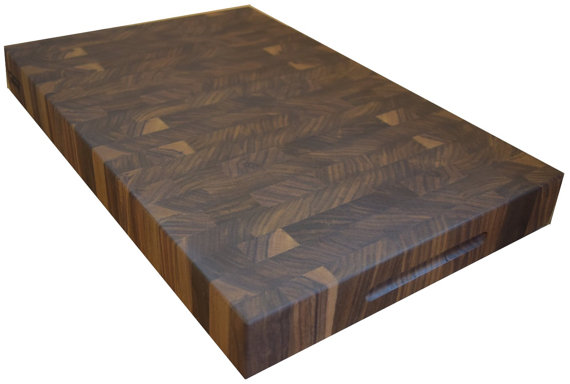- Medium End Grains
- >
- 16x12x1.5" Walnut End Grain
16x12x1.5" Walnut End Grain
SKU:
$178.00
178
224
$178.00 - $224.00
Unavailable
per item
Due to a recent surge in orders from popularity we will have a 2month construction time on new orders. Thanks for your patience!
Handcrafted from the highest grade solid black walnut hardwoods
End grain layout doesn't dull expensive knife blades & self heals from cutting use
Premium Wood Glue
16"x12"x1.5"
Finger Grips applied to side ends for easy lifting
Multiple coats of FDA grade mineral oil applied, then buffed with a moisture resistant bees wax top coat finish
FREE SHIPPNG to anywhere in the U.S. (Excluding Alaska & Hawaii)

Cutting Boards Made To Last- Being a smaller family business we pay close attention to the little details that make our work unique and our boards at a high quality control. Intricate staggered block layout to achieve the strongest wood joints possible. Clamping and wood preparation technique from a company that specializes solely in cutting boards allows for some of the tightest glue ups available on the market.
5stage sanding process makes for a smooth as butter feel
Whether you're a professional chef or a avid home cook this is a must have tool for the kitchen. Keep your knife blades sharp with this end grain constructed board. The wood configuration allows the blade to cut between the wood fibers not across and when the knife is lifted the fibers return to the original form. This design allows for a board that will outlast generations of users.
History & Info of the Tree hardwoods used in this board-
Walnut- The Royal Nut Tree
Walnut trees have a rich history dating back thousands of years. Walnuts from the tree are the oldest tree food known to man, dating back to 7000 B.C. The Romans called walnuts Juglans regia, "Jupiter's royal acorn." Early history indicates that English walnuts came from ancient Persia, where they were reserved for royalty.(Thus the name for our board Royalty Board) The walnut is often known as the "Persian Walnut." Walnuts were traded along the Silk Road route between Asia and the Middle East. Caravans carried walnuts to far off lands and eventually through sea trade, spreading the popularity of the walnut around the world. English merchant marines transported the product for trade to ports around the world and they became known as "English Walnuts." England, in fact, never grew walnuts commercially. The outer shell provided a natural protective layer helping to maintain the quality of the nut. Today the nut trade continues to be a well-established, ordered, and structured business, and the California walnut is well known as the top quality walnut for the world. Walnuts symbolized fertility and were strewn at weddings. Just the opposite, in Romania, brides who wished to delay childbearing placed into the bodice of their wedding dresses one walnut for each year they hoped to wait.
Throughout Eastern U.S., but principal commercial region is the Central states. Average tree height of 100 to 150 feet.
The sapwood of walnut is creamy white, while the heartwood is light brown to dark chocolate brown, occasionally with a purplish cast and darker streaks. The wood develops a rich patina that grows more lustrous with age. Walnut is usually supplied steamed, to darken sapwood. The wood is generally straight-grained, but sometimes with wavy or curly grain that produces an attractive and decorative figure. This species produces a greater variety of figure types than any other.
5stage sanding process makes for a smooth as butter feel
Whether you're a professional chef or a avid home cook this is a must have tool for the kitchen. Keep your knife blades sharp with this end grain constructed board. The wood configuration allows the blade to cut between the wood fibers not across and when the knife is lifted the fibers return to the original form. This design allows for a board that will outlast generations of users.
History & Info of the Tree hardwoods used in this board-
Walnut- The Royal Nut Tree
Walnut trees have a rich history dating back thousands of years. Walnuts from the tree are the oldest tree food known to man, dating back to 7000 B.C. The Romans called walnuts Juglans regia, "Jupiter's royal acorn." Early history indicates that English walnuts came from ancient Persia, where they were reserved for royalty.(Thus the name for our board Royalty Board) The walnut is often known as the "Persian Walnut." Walnuts were traded along the Silk Road route between Asia and the Middle East. Caravans carried walnuts to far off lands and eventually through sea trade, spreading the popularity of the walnut around the world. English merchant marines transported the product for trade to ports around the world and they became known as "English Walnuts." England, in fact, never grew walnuts commercially. The outer shell provided a natural protective layer helping to maintain the quality of the nut. Today the nut trade continues to be a well-established, ordered, and structured business, and the California walnut is well known as the top quality walnut for the world. Walnuts symbolized fertility and were strewn at weddings. Just the opposite, in Romania, brides who wished to delay childbearing placed into the bodice of their wedding dresses one walnut for each year they hoped to wait.
Throughout Eastern U.S., but principal commercial region is the Central states. Average tree height of 100 to 150 feet.
The sapwood of walnut is creamy white, while the heartwood is light brown to dark chocolate brown, occasionally with a purplish cast and darker streaks. The wood develops a rich patina that grows more lustrous with age. Walnut is usually supplied steamed, to darken sapwood. The wood is generally straight-grained, but sometimes with wavy or curly grain that produces an attractive and decorative figure. This species produces a greater variety of figure types than any other.

